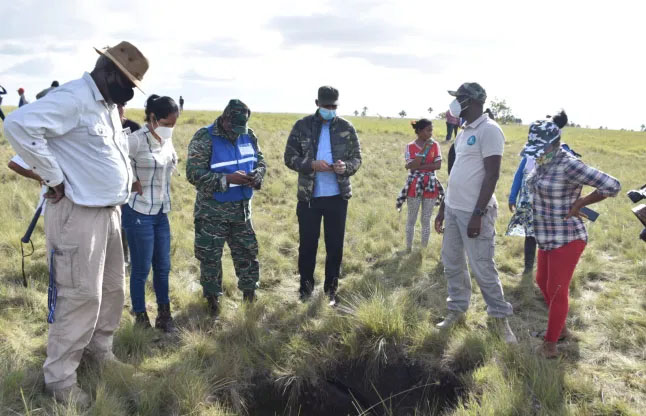A week after the region was jolted by a 5.7 quake, South Rupununi experienced a 4.6 aftershock on Sunday evening leaving residents anxious about the constant rumbling that has cracked the walls of 27 houses in Katoonarib.
The South Rupununi District Council (SRDC) on its Facebook page said that the Deputy Toshao reported that on Sunday evening at about 18.43 hours Katoonarib village experienced its “2nd hardest tremor accompanied by thunderous rumbling”.
The European-Mediterranean Seismological Centre listed Sunday’s aftershock at 4.6 on the Richter scale. No injuries have been reported from the tremors.
Meanwhile, Minister of Home Affairs, Robeson Benn yesterday met with a team comprising a Geological Specialist from the University of the West Indies’s (UWI) Seismic Research Centre, the Civil Defence Commission (CDC), and the Guyana Geology and Mines Com-mission (GGMC), to address the January 31st earthquake impact in the South Savannahs communities of Aishalton, Katoonarib and Sawariwau.
A release from the Ministry of Home Affairs said that the objective of the meeting was to “plot a way forward with respect to the impact of the earthquake and to discuss possible support and assessments needed to alleviate villagers’ fears of the aftershocks”.
The meeting touched on the risk assessments necessary for damage in the affected communities, and the need for scientific monitoring and surveys to be done along with detailed geological mapping of the affected areas.
Present at the meeting were Professor Lloyd Lynch and team from UWI, Director-General of the CDC, Lieutenant Colonel Kester Craig, and team and Javed Baksh and team from the GGMC.
The Minister also noted the need for civil engineers to advise on the way buildings are constructed in the affected communities so as to improve resilience.
In a visit to the communities over the weekend, Benn told residents that there is no need to relocate. The Department of Public Information (DPI) said that Benn on Saturday visited the villages of Katoonarib and Sawariwau, Deep South Rupununi, where there was structural damage and cracks in the earth’s surface. The walls of the Sawariwau Primary School have also been cracked according to the SRDC.
Benn, a geologist by profession, was accompanied by fellow geologist Leandro Pires, Director-General of the Civil Defence Commission, Lieutenant Colonel Craig, and a CDC team, DPI said.
Rare
During a community meeting in Katoonarib on Saturday, DPI said that Benn noted that earthquakes in that area were rare and persons should not migrate.
“This is not necessary, and it will only cause enormous distress, dislocation and unnecessary expenditure of money. There is no need to leave your homesteads to go to any other place.”
Benn also dispelled suggestions that the quake was caused by the oil extraction activities in Guyana’s maritime space.
“That is completely impossible. If that were the case, we would have lost the seawalls, the city of Georgetown and everything would have been in the ocean already. Not to happen all the way out here, some 700 miles in the Rupununi. It is totally unrelated, and I want to dispel those suggestions that it is related to oil extraction out on the coast or in the ocean.
“We have taken out much more volumes of pure water for drinking than we have for oil for those sediments going out there. So, those things are totally untenable in relation to these events”, DPI reported him as saying.
Benn said that a technical report on the earthquake’s effects would be completed and shared with the Government and the affected communities.
Head Teacher of Sawari-wau Primary, Lennox Henry said that vibrations and loud rumblings were being felt and heard continuously.
Pires noted that the rumbling sounds are normal following a quake and should not be a cause of concern. He added that a release of energy causes the noise through the cracks in the earth.
“It (is) supposed to happen for another couple of weeks, and then after that, it should finish. It is a very rare event for an earthquake to happen inside a stable plate like where the whole of South America is located, except for the Andes Mountains,” the geologist said.
Benn assured the residents that there would be seismic and audio monitoring and other assessments of the area.
One resident of Katoonarib whose wall collapsed, Grace Cyril, said that the incident occurred while she was out of the area. She expressed appreciation for the assistance provided by the Regional Democratic Council to repair her home.
“I have already received 16 zinc sheets, 10 sacks of cement and wooden materials.”
During an inspection in Katoonarib, DPI said that the team observed visible cracks in the earth and three areas of sizable depressions.
Over the next three days, a small team from the CDC will conduct continuous assessments in the affected communities.






